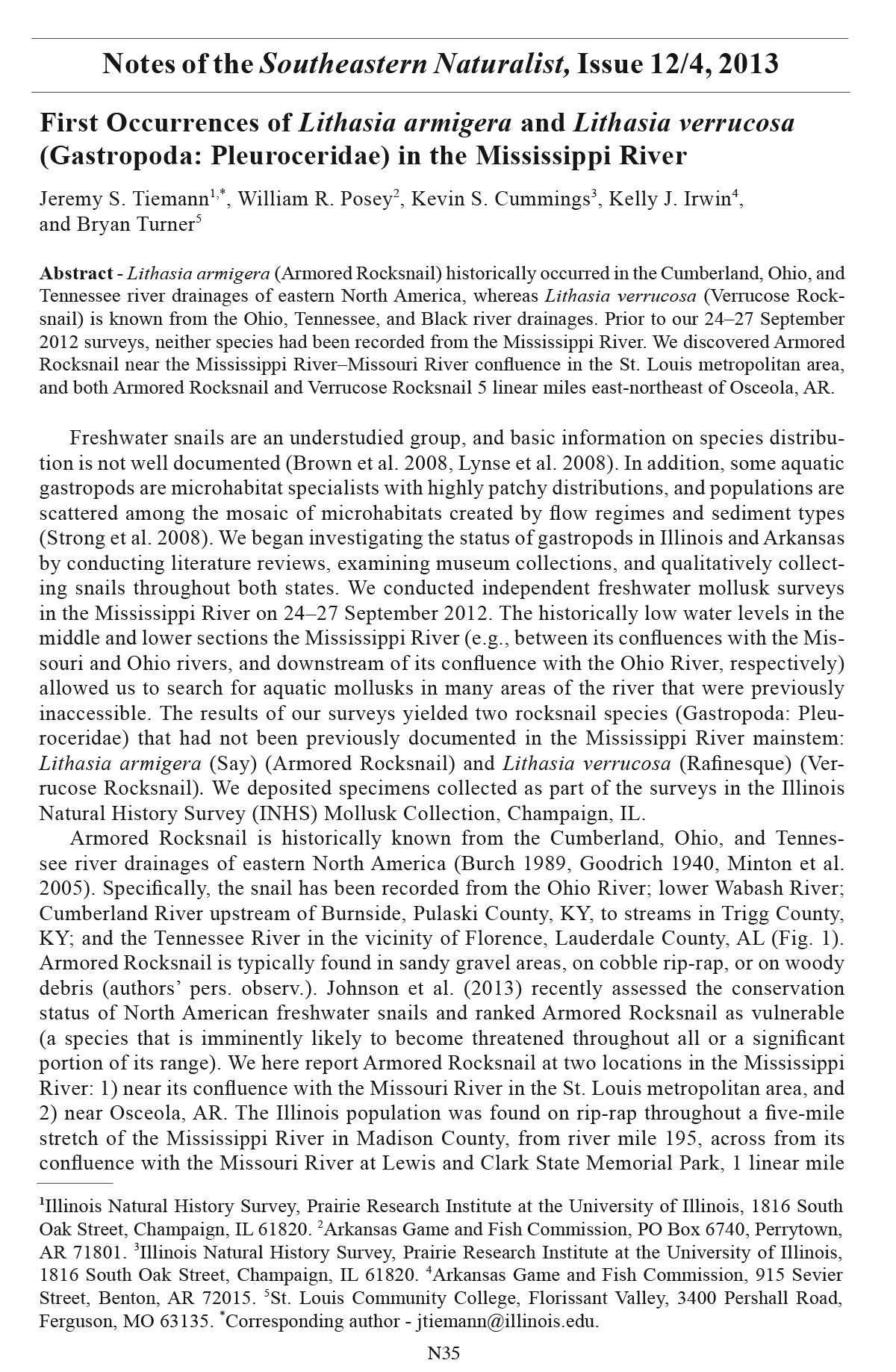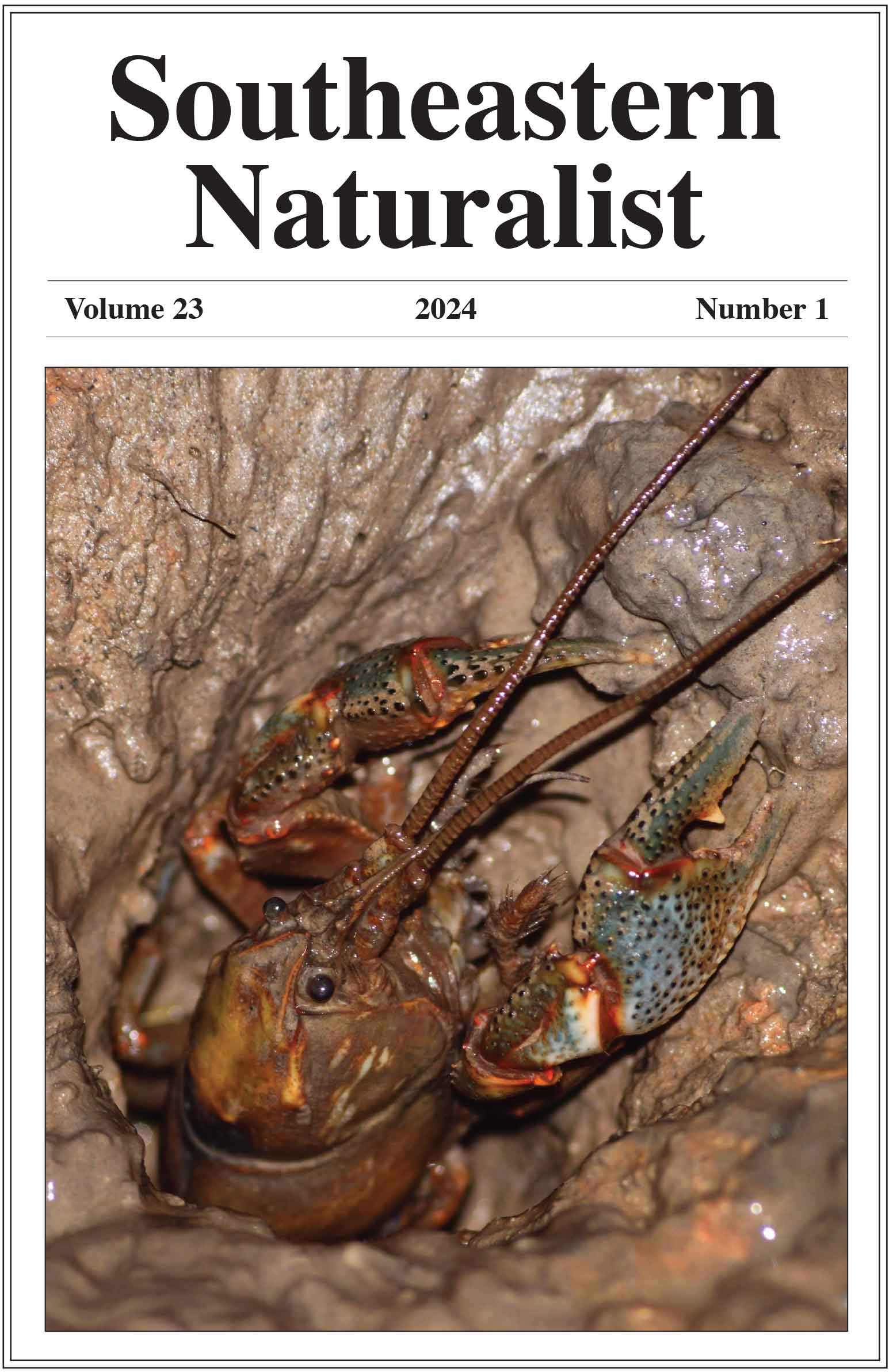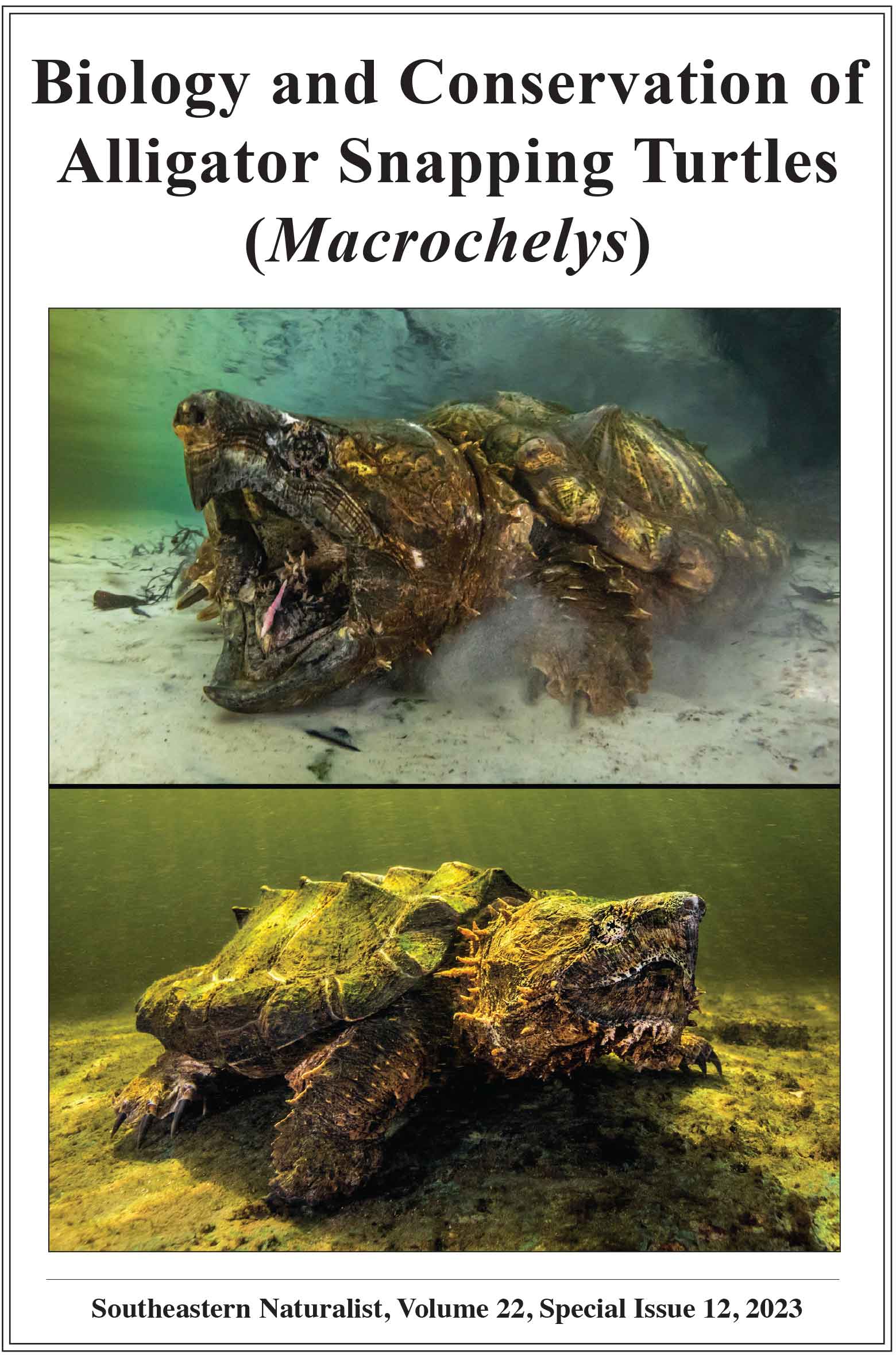First Occurrences of Lithasia armigera and Lithasia verrucosa (Gastropoda: Pleuroceridae) in the Mississippi River
Jeremy S. Tiemann, William R. Posey, Kevin S. Cummings, Kelly J. Irwin, and Bryan Turner
Southeastern Naturalist, Volume 12, Issue 4 (2013): N35–N39
Full-text pdf (Accessible only to subscribers.To subscribe click here.)

N35
2013 Southeastern Naturalist Notes Vol. 12, No. X
J.S. Tiemann, W.R. Posey, K.S. Cummings, K.J. Irwin, and B. Turner
First Occurrences of Lithasia armigera and Lithasia verrucosa
(Gastropoda: Pleuroceridae) in the Mississippi River
Jeremy S. Tiemann1,*, William R. Posey2, Kevin S. Cummings3, Kelly J. Irwin4,
and Bryan Turner5
Abstract - Lithasia armigera (Armored Rocksnail) historically occurred in the Cumberland, Ohio, and
Tennessee river drainages of eastern North America, whereas Lithasia verrucosa (Verrucose Rocksnail)
is known from the Ohio, Tennessee, and Black river drainages. Prior to our 24–27 September
2012 surveys, neither species had been recorded from the Mississippi River. We discovered Armored
Rocksnail near the Mississippi River–Missouri River confluence in the St. Louis metropolitan area,
and both Armored Rocksnail and Verrucose Rocksnail 5 linear miles east-northeast of Osceola, AR.
Freshwater snails are an understudied group, and basic information on species distribution
is not well documented (Brown et al. 2008, Lynse et al. 2008). In addition, some aquatic
gastropods are microhabitat specialists with highly patchy distributions, and populations are
scattered among the mosaic of microhabitats created by flow regimes and sediment types
(Strong et al. 2008). We began investigating the status of gastropods in Illinois and Arkansas
by conducting literature reviews, examining museum collections, and qualitatively collecting
snails throughout both states. We conducted independent freshwater mollusk surveys
in the Mississippi River on 24–27 September 2012. The historically low water levels in the
middle and lower sections the Mississippi River (e.g., between its confluences with the Missouri
and Ohio rivers, and downstream of its confluence with the Ohio River, respectively)
allowed us to search for aquatic mollusks in many areas of the river that were previously
inaccessible. The results of our surveys yielded two rocksnail species (Gastropoda: Pleuroceridae)
that had not been previously documented in the Mississippi River mainstem:
Lithasia armigera (Say) (Armored Rocksnail) and Lithasia verrucosa (Rafinesque) (Verrucose
Rocksnail). We deposited specimens collected as part of the surveys in the Illinois
Natural History Survey (INHS) Mollusk Collection, Champaign, IL .
Armored Rocksnail is historically known from the Cumberland, Ohio, and Tennessee
river drainages of eastern North America (Burch 1989, Goodrich 1940, Minton et al.
2005). Specifically, the snail has been recorded from the Ohio River; lower Wabash River;
Cumberland River upstream of Burnside, Pulaski County, KY, to streams in Trigg County,
KY; and the Tennessee River in the vicinity of Florence, Lauderdale County, AL (Fig. 1).
Armored Rocksnail is typically found in sandy gravel areas, on cobble rip-rap, or on woody
debris (authors’ pers. observ.). Johnson et al. (2013) recently assessed the conservation
status of North American freshwater snails and ranked Armored Rocksnail as vulnerable
(a species that is imminently likely to become threatened throughout all or a significant
portion of its range). We here report Armored Rocksnail at two locations in the Mississippi
River: 1) near its confluence with the Missouri River in the St. Louis metropolitan area, and
2) near Osceola, AR. The Illinois population was found on rip-rap throughout a five-mile
stretch of the Mississippi River in Madison County, from river mile 195, across from its
confluence with the Missouri River at Lewis and Clark State Memorial Park, 1 linear mile
1Illinois Natural History Survey, Prairie Research Institute at the University of Illinois, 1816 South
Oak Street, Champaign, IL 61820. 2Arkansas Game and Fish Commission, PO Box 6740, Perrytown,
AR 71801. 3Illinois Natural History Survey, Prairie Research Institute at the University of Illinois,
1816 South Oak Street, Champaign, IL 61820. 4Arkansas Game and Fish Commission, 915 Sevier
Street, Benton, AR 72015. 5St. Louis Community College, Florissant Valley, 3400 Pershall Road,
Ferguson, MO 63135. *Corresponding author - jtiemann@illinois.edu.
Notes of the Southeastern Naturalist, Issue 12/4, 2013
2013 Southeastern Naturalist Notes Vol. 12, No. X
N36
J.S. Tiemann, W.R. Posey, K.S. Cummings, K.J. Irwin, and B. Turner
upstream of the Chain of Rocks Canal entrance (38.80529°N, 90.11574°W; INHS #43832),
to river mile 189.5, the first wing-dam downstream of the Chain of Rocks dam (38.74756°N,
90.17827°W; INHS #43861) by J.S. Tiemann, K.S. Cummings, and B. Turner. Snail densitities
were less than 5 individuals/m2, except for on the boulders in Chain of Rocks dam at river mile
190.3 (38.75596°N, 90.17205°W; INHS #43859), where density was about 100 individuals/
m2. We failed to find Armored Rocksnail at 27 sites in the Mississippi River between river
mile 184.5, at the end of Gabaret Island, Madison County (38.68976°N, 90.19269°W) to
the river’s confluence with the Ohio River at Fort Defiance State Park near Cairo, Alexander
County (36.98308°N, 89.13912°W). We also failed to find the snail upstream of river
mile 195 to Lock and Dam 26 (38.86582°N, 90.14231°W). The Arkansas population of
Armored Rocksnail was found in the Mississippi River at river mile 791, along Kate Aubrey
Towhead, 5.5 linear miles east-northeast of Osceola, Mississippi County, AR (35.74404°N,
89.87894°W; INHS #43433) by W.R. Posey and K.J. Irwin. Unlike the Illinois specimens,
the Arkansas specimens were all empty shells found on a gravel bar in concentrated,
wave-swept piles along the water’s edge. The nearest documented population of Armored
Rocksnail to the newly discovered Illinois and Arkansas sites occurs in the Ohio River at
river mile 974, Mound City, Pulaski County, IL (37.07804°N, 89.16529°W; INHS #32727;
Tieman et al. 2011), which is a distance of 197 river miles from the Illinois population near
St. Louis, and 169 river miles from the Arkansas population (noting that the Mississippi
River’s mile markers change at its confluence with the Ohio River).
Figure 1. Distribution map of Lithasia armigera. Two new locations on Mississippi River are indicated
with a star.
N37
2013 Southeastern Naturalist Notes Vol. 12, No. X
J.S. Tiemann, W.R. Posey, K.S. Cummings, K.J. Irwin, and B. Turner
Verrucose Rocksnail is historically known from the Ohio, Tennessee, and Black river
drainages of North America (Burch 1989, Goodrich 1940, Minton and Lydeard 2003).
Specifically, the snail has been recorded from the Ohio River; lower Wabash River; Tennessee
River from eastern Tennessee to Marshall County, KY; and Black and Spring rivers,
AK (Fig. 2). As with the Armored Rocksnail, the Verrucose Rocksnail is typically found in
sandy gravel areas, on cobble rip-rap, or on woody debris (authors’ pers. observ.). Johnson
et al. (2013) ranked Verrucose Rocksnail as currently stable (species populations not currently
at risk). Empty shells of Verrucose Rocksnail were found with Armored Rocksnail
in concentrated, wave-swept piles along the water’s edge of a gravel bar in the Mississippi
River at river mile 791, along Kate Aubrey Towhead, 5.5 linear miles east-northeast of
Osceola, Mississippi County, AR (35.74404°N, 89.87894°W; INHS #43434) by W.R. Posey
and K.J. Irwin. Although the Black River population is closer in terms of linear distance
(approximately 70 miles), in terms of river miles, the nearest documented population of
Verrucose Rocksnail occurs in the Ohio River at Mound City (INHS #32728; Tiemann et
al. 2011), which is a distance of 169 river miles. Minton and Lydeard (2003) suggested that
Verrucose Rocksnails from the Black River drainage, in Arkansas, are genetically distinct
from the lower Ohio River populations.
Neither Armored Rocksnail nor Verrucose Rocksnail had been documented in the Mississippi
River mainstem prior to our survey (e.g., Baker 1906, 1928; Burch 1989; Dawley
1947; Goodrich 1939; Stewart 2006; Wu et al. 1997). It is beyond the scope of our study
Figure 2. Distribution map of Lithasia verrucosa. New location on the Mississippi River is indicated
with star.
2013 Southeastern Naturalist Notes Vol. 12, No. X
N38
J.S. Tiemann, W.R. Posey, K.S. Cummings, K.J. Irwin, and B. Turner
to determine if these populations are native or introduced. Given the distance to the next
known population, these Mississippi River populations could represent unique genetic
stocks. Future studies could utilize other methods (e.g., trawling or diving) to assess the
snail populations in the middle and lower Mississippi River, and examine genetics to determine
the origin of the populations (e.g., Hayes et al. 2007).
Acknowledgments. Funds were provided in part by a grant from the Illinois Department
of Natural Resources’ Wildlife Preservation Fund (#13-031W) and the Illinois Department of
Transportation, Springfield, IL. B. Dabney, H. Dunn, S.M. Jaworski, B. Lubinski, J.E.
Petzing, and D. Shasteen assisted in collecting Illinois specimens, and J. Harris assisted in
collecting Arkansas specimens. J.L. Sherwood assisted in map creation. A.J. Baldinger, the
Museum of Comparative Zoology, Cambridge, MA; P. Callomon, the Academy of Natural
Sciences of Drexel University, Philadelphia, PA; D.Ó. Foighil, the University of Michigan
Museum of Zoology, Ann Arbor, MI; J. Gerber, Field Museum of Natural History, Chicago,
IL; T. Pearce, the Carnegie Museum of Natural History, Pittsburgh, PA; D. Roberts, Chicago
Academy of Science, Chicago, IL; J. Slapcinsky, the University of Florida Museum of Natural
History, Gainesville, FL; and G.T. Watters, the Ohio State University Museum of Zoology,
Columbus, OH, generously provided access to specimens under their care. P. Morrison and J.
Clayton provided Ohio River specimens. B. Tiemann offered constructive criticism.
Literature Cited
Baker, F.C. 1906. A catalogue of the Mollusca of Illinois. Bulletin of the Illinois State Laboratory of
Natural History 7(6):53–136.
Baker, F.C. 1928. The fresh water Mollusca of Wisconsin. Part I: Gastropoda. Bulletin of the Wisconsin
Geological and Natural History Survey, University of Wisconsin 70(2):vi–495 + 76 plates.
Brown, K.M., B. Lang, and K.E. Perez. 2008. Conservation ecology of North American pleurocerid
and hydrobiid gastropods. Journal of North American Benthological Society 27(2):484–495.
Burch, J.B. 1989. North American Freshwater Snails. Malacological Publications, Hamburg, Michigan.
viii + 365 pp.
Dawley, C. 1947. Distribution of aquatic mollusks in Minnesota. American Midland Naturalist
38(3):671–697.
Goodrich, C. 1939. Pleuroceridae of the Mississippi River basin exclusive of the Ohio River system.
Occasional Papers of the Museum of Zoology, Univeristy of Michigan 406:1–4.
Goodrich, C. 1940. The Pleuroceridae of the Ohio River drainage system. Occasional Papers of the
Museum of Zoology, University of Michigan 417:1–21.
Hayes, D.M., R.L. Minton, and K.E. Perez. 2007. Elimia comalensis (Gastropoda: Pleuroceridae)
from the Edwards Plateau, Texas: Multiple unrecognized endemics or native exotic? American
Midland Naturalist 158(1):97–112.
Johnson, P.D., A.E. Bogan, K.M. Brown, N.M. Burkhead, J.R. Cordeiro, J.T. Garner, P.D. Hartfield,
D.A.W. Lepitzki, G.L. Mackie, E. Pip, T.A. Tarpley, J.S. Tiemann, N.V. Whelan, and E.E. Strong.
2013. Conservation status of freshwater gastropods of Canada and the United States. Fisheries
38(6):247–282.
Lysne, S.J., K.E. Perez, K.M. Brown, R.L. Minton, and J.D. Sides. 2008. A review of freshwater gastropod
conservation: Challenges and opportunities. Journal of the North American Benthological
Society 27(2):463–470.
Minton, R.L., and C. Lydeard. 2003. Phylogeny, taxonomy, genetics and global ranks of an imperilled,
freshwater snail genus Lithasia (Pleuroceridae). Molecular Ecology 12(1):75–87.
Minton, R.L., S.P. Savarese, Jr., and D.C. Campbell. 2005. A new species of “Lithasia” (Mollusca:
Caenogastropoda: Pleuroceridae) from the Harpeth River, Tennessee, USA. Zootaxa 1054:31–42.
Stewart, T.W. 2006. The freshwater gastropods of Iowa (1821–1998): Species composition, geographic
distributions, and conservation concerns. American Malacological Bulletin 21(1–2):59–75.
N39
2013 Southeastern Naturalist Notes Vol. 12, No. X
J.S. Tiemann, W.R. Posey, K.S. Cummings, K.J. Irwin, and B. Turner
Strong, E.E., O. Gargominy, W.F. Ponder, and P. Bouchet. 2008. Global diversity of gastropods (Gastropoda;
Mollusca ) in freshwater. Hydrobiologia 595(1):149–166.
Tiemann, J.S., K.S. Cummings, and C.A. Mayer. 2011. Distribution of pleurocerids (Gastropoda)
of Illinois. INHS Technical Report 2011(9). Final report submitted to the Illinois Department of
Natural Resources, Springfield, IL. 36 pages + appendix.
Wu, S.K., R.D. Oesch, and M.E. Gordon. 1997. Missouri Aquatic Snails. Missouri Department of
Conservation, Natural History Series, Number 5, Jefferson City, MO. 97 pp.













 The Southeastern Naturalist is a peer-reviewed journal that covers all aspects of natural history within the southeastern United States. We welcome research articles, summary review papers, and observational notes.
The Southeastern Naturalist is a peer-reviewed journal that covers all aspects of natural history within the southeastern United States. We welcome research articles, summary review papers, and observational notes.